

So Cal Climate Gardening is different in So Cal – our climate is called “dry summer subtropical climate” – mild winters with some rain, warm and dry summers with no rain. Our climate is closer to other areas around the world with the same latitude ie: So Africa, southwestern Australia. Distance from equator makes our temperatures subtropical but our position on the southwest corner of No American continent keep summers dry. The temperature is also moderated by nearby Pacific Ocean but it depends on how close to the coast you are. The region has mild, mostly dry weather, with an average of 201 days above 70 °F (21 °C) and low rainfall (9–13 inches [23–33 cm] annually). We are about 20 miles from the coast and we seem to sit on the border of coastal and inland patterns – sometimes we get the coastal fog and the “Marine Layer” fog that keeps the temps cooler. When this coastal influence is weak, the true nature of So Cal comes through loud and clear – it’s a desert and can be 15-20 degrees hotter and dryer. Temecula, which is 10 miles northeast of Fallbrook and the other side of the foothills is usually more hot and dry. Micro climates These are small areas within a climate zone where physical characteristics that produce slightly varying climates. Within your own backyard you are going to find these variations, ie: east side vs west, variations in elevation. Even on our small farm, we have two distinct climates. Up above, we have high desert and down in the barrancas or ravines that contain several springs that run year round, it’s a riparian forest – damp and cool! 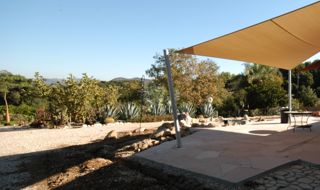 above, dry with cactus 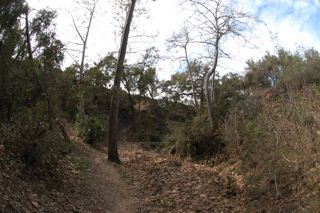 down in the barranca (ravine) it's damp with running springs and even ferns - plus a nature trail! Determining your Microclimate Sunset magazine and the Sunset Yearbooks are great resources for this information. The magazine has regional additions so that the garden advice is tailored to your region. Here is their link to the climate zones for the San Diego Region – these zones guide you in choosing the right plants for your garden. There are detailed description of each zone. It’s still challenging because there are so many micro-climates. Where we are in Fallbrook we seem to fall between zone 21 and 19. Even on our property, we can see that there are differences. http://www.sunset.com/garden/climate-zones/sunset-climate-zone-san-diego-area-00418000067314/ The So Cal “Seasons” When we lived in Boston, we had a very set idea of what happens in each season of the year – especially as a gardener. You would see the crocuses pop out in March and plant your peas around St Patrick’s Day. Then enjoy a short but intense planting and harvesting season from the date of the last frost until the date of the first frost in the fall – that about sums it up. So Cal has its own seasonal rhythms and milestones. It took some time to even figure out when the defined “seasons” begin and end. I’m still trying to figure it out especially as it applies to when to grow things. Here’s the deal as I can best figure it: Spring This is a busy time for gardeners in So Cal, beginning in March and going into April when you will be planting the bulk of your “Warm Season” crops. We still have to be careful about frost until the middle of March. The rains that hopefully began in December should be tapering off now but the garden will be lush and green for a while. You’ll hear the term “May gray, June gloom, July fry” to describe this transition from Spring to Summer. During the spring the “Marine Layer” keeps the area cool with sometimes dense fog much of the time. This changes dramatically in July when the “fry” part usually starts although summer of 2011 has seen this overnight coastal fog continuing in to September. Summer By the time “official” summer arrives in June, all your “warm weather” crops are in the ground with a properly adjusted irrigation system delivering the right amount of moisture directly to the plant and everything nicely mulched to prepare for the hot weather arriving in July. It’s usually too hot to plant – you’ll have to wait for the fall to start your “winter garden”. And hot it gets where we are. We have a tem/humidity gauge on the patio and when it hits over 99 degrees C and under 20% humidity, it’s simply “off the charts” and reads Hi/Lo. This situation is the perfect set-up for the fire season, which plagues So Cal. In fact, fire is considered part of the natural ecology of the region. The native plants tell you a lot about the area – for instance, Sage is plentiful here and grows lush and colorful with the winter rains (I have a terrific “Hot Lips” sage that is one of the highlights of the garden). But Sage turns to dry tinder ready to burn when the rain stops and there are acres and acres of dry brush throughout So Cal. This is such a natural process that the seeds of some native plants actually germinate when burned. The Live Oak tree is an example of native tree that can survive a major fire. 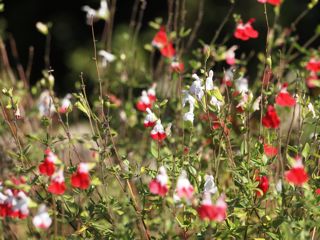 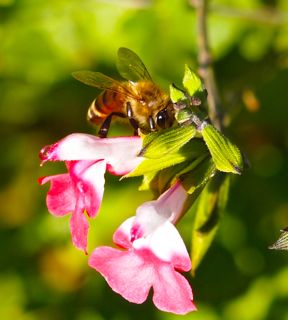 ( "Hot Lips" sage) Fall Normal fall months are just a continuation of hot and dry. By the time you reach October, it probably has not rained since March and it’s bone dry. Santa Ana winds occur, blowing from the Mojave desert to the ocean. Maritime moisture is pushed out to sea and vegetation becomes dry. Everything is dry - my skin felt like parchment paper! This is the height of the fire season. 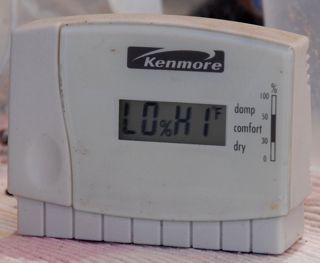 This indicates temperature 99 degrees and humidity <20%. The hot, dry weather usually starts to break in Nov/Dec with the first rain since March or April. This means only 3-4 months of rain in a typical year Living with the Threat of Fire This fire threat has taken some getting used to – regular as clockwork – here’s the recent history: On Oct. 25–29 2003, in Southern Calif 15 devastating forest fires burned for two weeks, primarily in San Diego County, Ventura County, Riverside County, and San Bernardino County, forcing more than 80,000 people to evacuate their homes and burning 800,000 acres. More than 15,500 firefighters battled the blazes that killed 24 people and destroyed 3,640 homes. The Cedar Fire in San Diego, which burned through 200,000 acres, was the largest fire in California's history. The October 2007 California wildfires were a series of wildfires that began burning across Southern California on October 20. At least 1,500 homes were destroyed and over 500,000 acres of land burned from Santa Barbara County to the U.S.–Mexico border. Nine people died as a direct result of the fires, 85 others were injured, including at least 61 firefighters. We watched the 2003 fire on television - it did not come close to us. For the 2007 fire, we left town the morning the fire came bearing down on us from the east. We took our birds but nothing else and heading to LA to wait it out. By that afternoon, 30,000 people were asked to evacuate. We are glad we missed that traffic jam. Almost everyone we know in So Cal has a hair-raising story to tell.  View of the hill just east of our house burned in the October, 2007 fire. The fire came within about ¼ mile of the house but no damage. The fire was intense enough that the citrus trees showed wilted leaves on the side facing the fire. Fruit yield was off the next year or so but the trees made a full recovery. 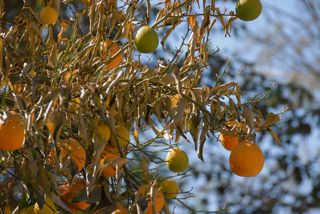 You always have fire in mind when you plan your garden – it certainly caused us to alter our property. We had to remove over thirty 25' poplar trees (described as a “Roman Candle” when burning) near the house as well as pine trees and replaced them with a succulent garden. Succulents have thick, fleshy leaves that do not burn. We built a 6 ft high brick wall around the perimeter of the property to act as a fire stop (we call it “The Great Wall of Fallbrook”). Also, everything on the patio is metal or concrete – no wood to burn. It helped that our son Mike was making concrete tables at the time. More photos of the October, 2007 fires are here. Winter Winters are mild – we will get an at least several days (nights) of mid 30’s weather with mild frost danger. Seldom do we see temps drop below 30 but you must be vigilant. We have seen major damage to the Avocado crops around us (no permanent damage to the trees, however). How much frost you get depends on your micro-climate (see that section). It means that we cannot grow the true tropical plants – mangoes, bananas. Some areas of Fallbrook closer to the coast can grow them. We can, however, grow things that like colder nights such as apples and asian pears. There are ways to protect smaller trees from frost damage by putting up a frame around them and throwing up a tarp over the plant at night. The frame prevents the tarp from sitting on the tree so that air can circulate. You take the tarp off during the day to let the sun warm it up. We had a young mango tree that made it through the first year but succumbed the second year when the frost was more severe. Lesson learned – can’t fool Mother Nature – our microclimate with occasional frost prevents us from growing tropical plants. 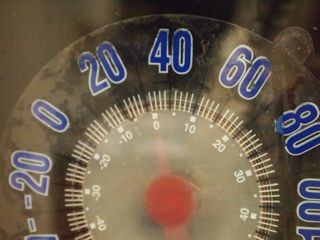  During the winter, the weather turns around and the hot, dry desert influence wanes and the ocean influence moves in, bringing much needed rain usually falling between December and March. Precipitation is low - usually 9 – 13” and some years it all falls on 2 or 3 days in monsoon proportions. These intense downpours can cause rapid runoff and initiate landslides on unstable slopes. This is so common in our area that we say the monsoon rain was just visiting on its way to the ocean. Another example of how dire the water situation is in So Cal - 80-90% of the water is imported and the little we get we often does not even penetrate the soil.  water running down the hill from the house 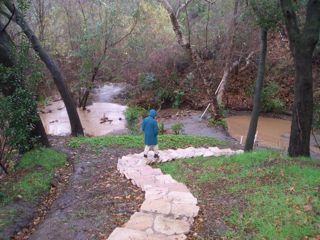 and the barranca flooded (R) 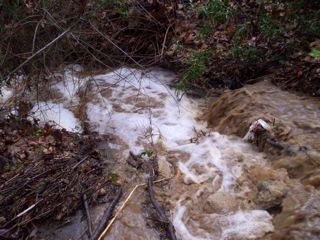 Landslides When the rain falls so intensely on our clay soil we get landslides because our property sits high on slip of land with deep ravines on either side. The hills are always giving way and we have become experts on erosion control. We learned a new term: the “angle of repose” – the steepest angle of descent of a slope when the slope face is on the verge of sliding. As applied to our situation, it means that we have to shave off the angle of a hill that is in danger of sliding so that we can replant it and cover it with special woven mats that holds the dirt on the hill but allows plants to grow through. We have had major landslides and a century-old Live Oak tree topple over. We have had to rebuild some sections completely – it’s a constant battle. 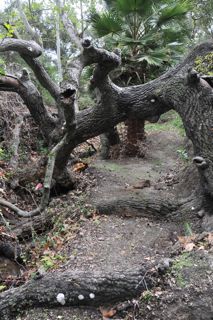 The live oak that fell  landslide carried away barrier made from railroad ties Here’s another way to look at the four So Cal “seasons”: “rain, mudslides, wind and fire.” |
| Food Chain Farm Homepage and Table of Contents |
| See us on the HPWREN Webcam: http://hpwren.ucsd.edu/cameras/RedMtn.html |